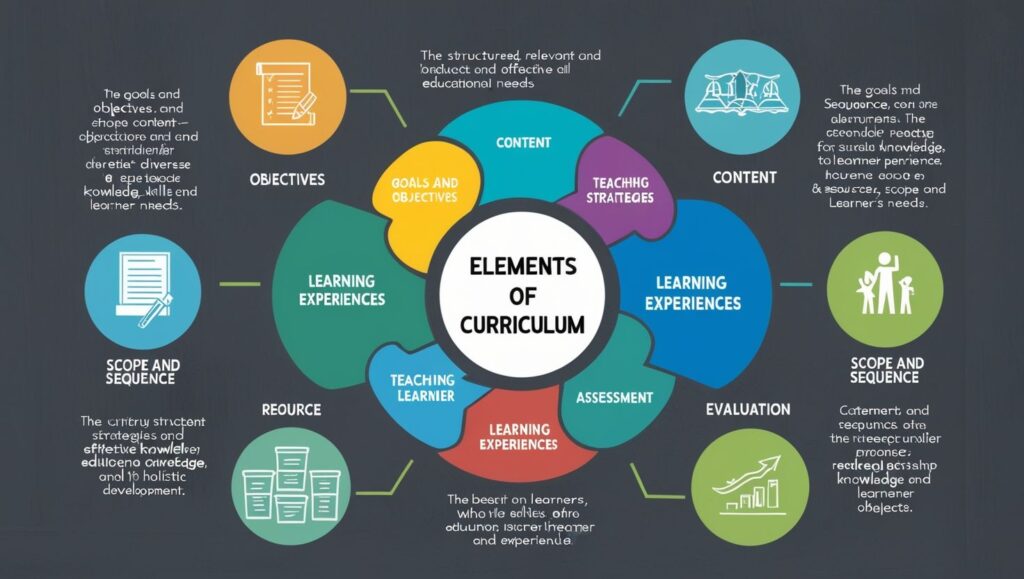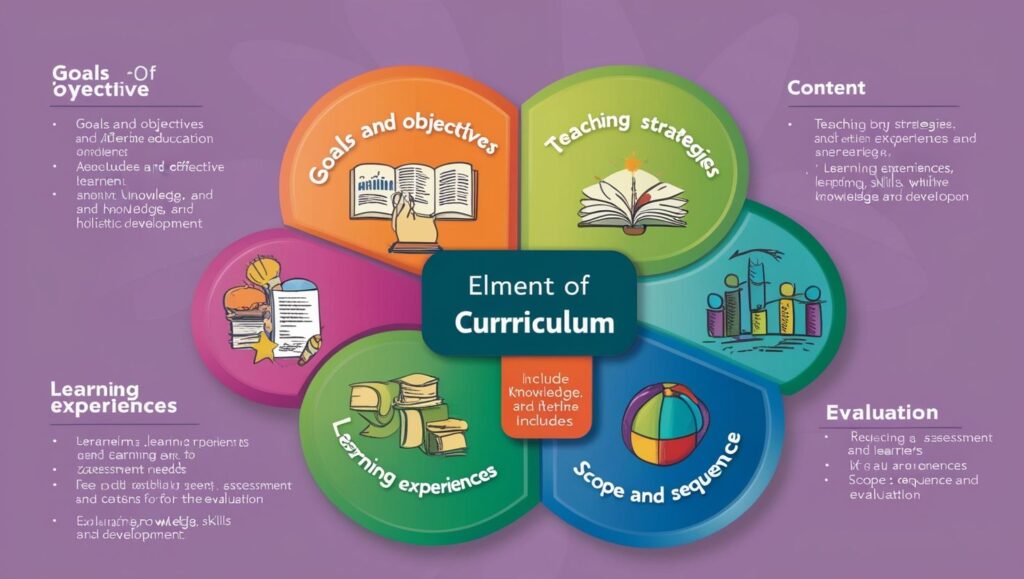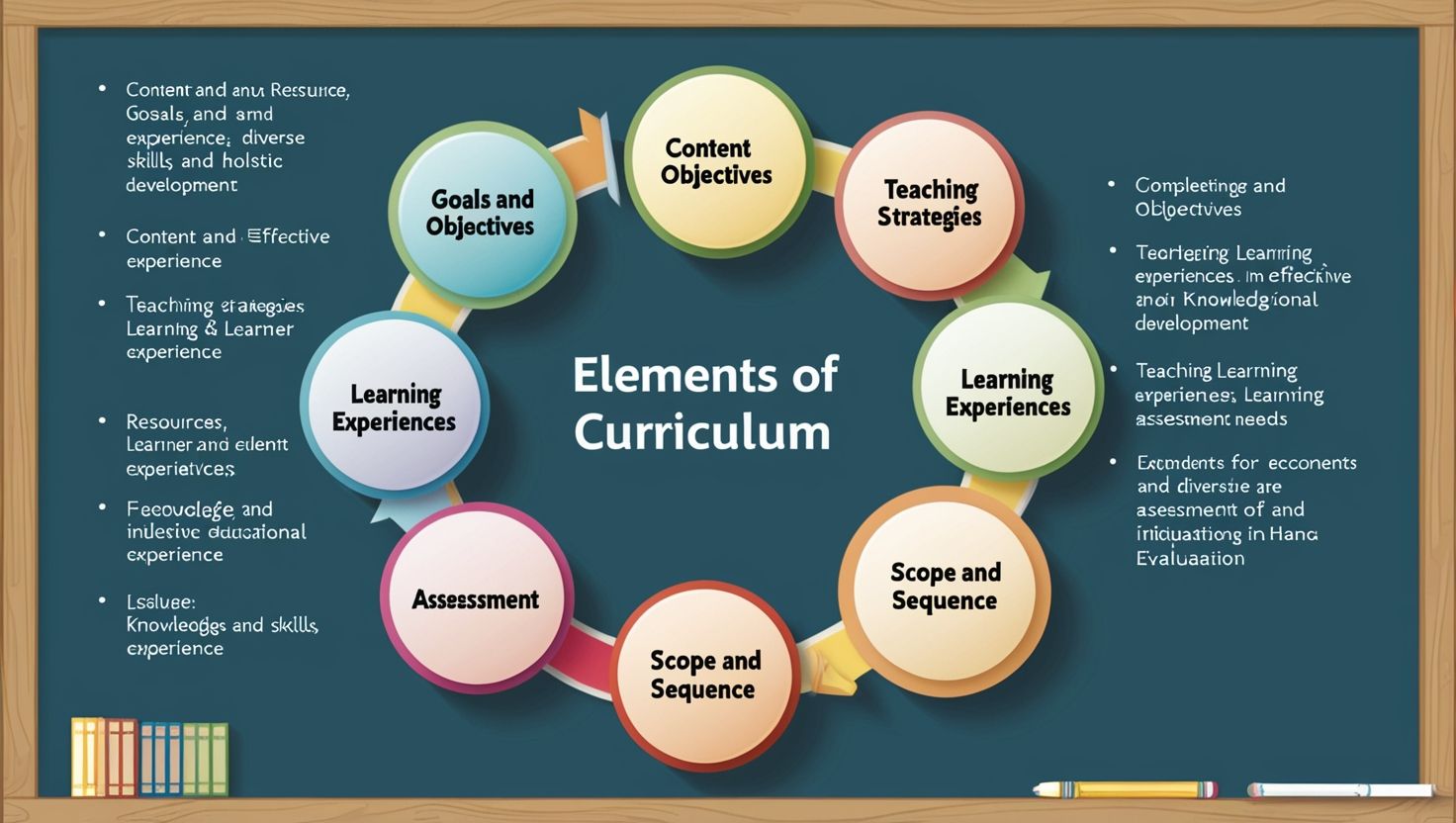Elements of Curriculum, The curriculum is a cornerstone of education, serving as a framework that outlines the learning experiences and goals for students within an academic setting. It encompasses the knowledge, skills, and attitudes that educational institutions aim to instill in learners. Understanding the key elements of the curriculum is essential for educators, policymakers, and stakeholders to ensure effective learning and development. This article delves into the fundamental elements of the curriculum, their significance, and how they interact to create meaningful educational experiences.
1. Goals and Objectives
Definition:
Goals and objectives define what students are expected to learn and achieve during their educational journey. Goals are broad, overarching aspirations, while objectives are specific, measurable, and time-bound milestones aligned with these goals.
Significance:
Clear goals and objectives provide direction to the teaching-learning process. They serve as a guide for educators in designing lesson plans and assessing student progress. For instance, a science curriculum might aim to develop critical thinking skills as a goal, while an objective could specify that students should analyze and interpret experimental data by the end of the term.
2. Content
Definition:
The content refers to the subject matter, knowledge, and skills that students are expected to learn. It includes facts, concepts, theories, and procedures across various disciplines.
Significance:
Content is the core of the curriculum and reflects cultural, social, and academic priorities. It must be relevant, up-to-date, and appropriately challenging. For example, a history curriculum may focus on significant events, cultural milestones, and critical thinking about historical sources. The selection of content should also align with the developmental stages and needs of learners.

3. Learning Experiences
Definition:
Learning experiences encompass the methods, activities, and environments through which students engage with the content and achieve the objectives. These experiences include classroom instruction, projects, field trips, discussions, and hands-on activities.
Significance:
Effective learning experiences are interactive and student-centered, fostering engagement and deeper understanding. For instance, incorporating group projects in a curriculum helps students develop collaboration and problem-solving skills. Diverse learning experiences also cater to different learning styles, ensuring inclusivity and accessibility.
4. Teaching Strategies
Definition:
Teaching strategies refer to the approaches and techniques employed by educators to deliver content and facilitate learning. These strategies include lectures, inquiry-based learning, cooperative learning, and differentiated instruction.
Significance:
The choice of teaching strategies significantly impacts how effectively students grasp the content and achieve the objectives. For example, using a flipped classroom model allows students to explore content independently before engaging in collaborative activities in class. Effective strategies also adapt to technological advancements, integrating tools like virtual labs or gamified learning platforms.
5. Assessment and Evaluation
Definition:
Assessment involves measuring students’ performance and understanding of the content, while evaluation focuses on determining the effectiveness of the curriculum and teaching methods. Assessments can be formative (ongoing) or summative (end-of-term).
Significance:
Assessment and evaluation are crucial for identifying gaps in learning, providing feedback, and refining instructional methods. For example, standardized tests evaluate knowledge retention, while performance-based assessments like presentations or portfolios measure practical application. Evaluating the curriculum itself ensures that it remains relevant and impactful.
6. Scope and Sequence
Definition:
Scope refers to the breadth and depth of content covered within a curriculum, while sequence defines the logical order in which topics are introduced.
Significance:
A well-structured scope and sequence ensure that learning progresses logically and systematically. For instance, in mathematics, foundational concepts like addition and subtraction must precede more complex topics like algebra. Proper sequencing also prevents redundancy and overload, enhancing the overall learning experience.
7. Resources and Materials
Definition:
Resources and materials include textbooks, digital tools, visual aids, and other supplementary materials that support teaching and learning.
Significance:
The availability and quality of resources directly affect the curriculum’s implementation. For example, modern classrooms equipped with interactive whiteboards and online resources can provide dynamic and engaging lessons.
8. Learner-Centered Focus
Definition:
A learner-centered focus places the needs, interests, and abilities of students at the forefront of curriculum design and delivery.
Significance:
This approach acknowledges that students learn differently and thrive in varied environments. Incorporating choice, such as elective subjects or project topics, empowers students and fosters intrinsic motivation. For example, a curriculum allowing students to select a research topic aligns their education with personal interests and career aspirations.

9. Cultural and Social Relevance
Definition:
Cultural and social relevance ensures that the curriculum reflects the values, traditions, and issues of the society it serves.
Significance:
A culturally responsive curriculum promotes inclusivity and prepares students to be active, informed citizens. For example, a curriculum that includes local history and global issues encourages students to appreciate diversity and think critically about societal challenges.
10. Flexibility and Adaptability
Definition:
Flexibility refers to the curriculum’s ability to accommodate changes in educational needs, societal demands, and technological advancements.
Significance:
A flexible curriculum remains relevant in an ever-changing world. For instance, incorporating emerging fields like artificial intelligence or environmental science ensures students are prepared for future challenges. Adaptability also allows teachers to tailor instruction to specific classroom dynamics.
11. Integration and Interdisciplinarity
Definition:
Integration involves connecting different subjects and themes to create a cohesive learning experience. Interdisciplinary approaches combine multiple disciplines to address complex issues.
Significance:
Integrated curricula promote holistic understanding and the application of knowledge across contexts. For example, a project on sustainable development might combine science, geography, and economics. This approach enhances critical thinking and problem-solving skills, equipping students to tackle real-world challenges.
12. Evaluation of the Curriculum
Definition:
Curriculum evaluation involves assessing its effectiveness in achieving educational goals and meeting the needs of students and society.
Significance:
Regular evaluation ensures that the curriculum remains relevant, effective, and aligned with current educational standards. Stakeholder feedback, including from teachers, students, and parents, plays a crucial role in this process. For instance, periodic reviews can identify outdated content and highlight areas for improvement.
Challenges in Curriculum Design
While the elements of the curriculum provide a robust framework, challenges often arise during implementation. These include:
- Balancing breadth and depth: Ensuring comprehensive coverage without overwhelming students.
- Catering to diverse needs: Addressing the varied abilities and interests of students within a single framework.
- Resource limitations: Adapting the curriculum in under-resourced settings.
- Resistance to change: Overcoming inertia in adapting to new educational paradigms.
Conclusion
The elements of the curriculum work in tandem to create a structured and meaningful educational experience. From setting clear objectives to ensuring cultural relevance, each component plays a vital role in shaping students’ intellectual, emotional, and social development. By addressing challenges and embracing flexibility, educators and policymakers can design curricula that prepare learners for the complexities of the modern world.

5 thoughts on “Elements of Curriculum”
Comments are closed.